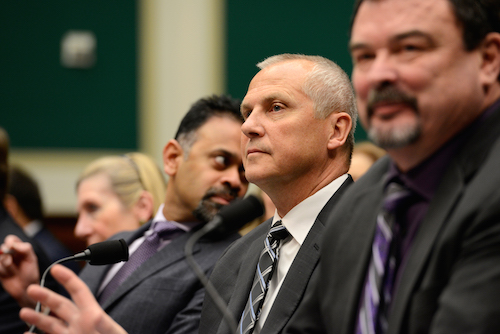America’s energy infrastructure was on Capitol Hill’s agenda
last week, and the IBEW was there to provide some expertise.

|
| IBEW International President Lonnie R. Stephenson testified before the House of Representatives Energy and Commerce Committee on Feb. 15, joining other industry experts in support of grid modernization.
|
International President Lonnie R. Stephenson discussed the pressing need for a 21st century electrical grid on Feb. 15 when he appeared before the U.S. House of Representatives Energy and Commerce Committee.
“We need a truly national grid and new transmission lines that can safely and reliably transfer power – including renewables like wind and solar – from energy rich regions to those parts of the country most in need,” he said. “And that means we need new transmission projects that will cross multiple jurisdictions and state lines.”
Stephenson cited the proposed Clean Lines project planned to deliver clean and low-cost electricity but which has encountered regulatory resistance from state and local jurisdictions. These high voltage transmission lines sought to transport wind power from states like Kansas to the East Coast.
“Just like the Interstate Highway System, the modern transmission lines of the 21st century can’t stop at the state line. But it only takes one local commission or regulatory board to delay a project like Clean Lines indefinitely,” Stephenson said.
The hearing demonstrated a bipartisan interest on the part of the committee members to learn what the country needs and what the federal government should do to assist.
“We have the resources to get this done, we only need the will to do it,” said Rep. Frank Pallone of New Jersey and ranking member of the committee.
Many Republican members stated interest in relaxing regulations, which could solve some of those jurisdictional delays, creating more clean energy projects and jobs for IBEW members, said International Representative Breana Malloy.
“An impressive number of representatives said they had visited our training centers and were impressed. Some mentioned having fathers or other family members who were linemen,” Malloy said. “Hopefully this knowledge and experience will translate to a time of opportunity for our membership.”
Much of the new technology will be digital but as Stephenson and other panelists said, there is still a gaping need for more pipes and wires – and the skilled workforce to build them.
“We’re constantly looking at projections and workforce need, and are training on the latest technology,” Stephenson said, stressing the value of IBEW apprenticeships that are self-funded through collective bargaining agreements.
Stephenson also spoke about the need for reliable energy from baseload sources like nuclear and coal that supply constant, steady electricity, unlike wind and solar. Recent state actions in New York and Illinois to keep nuclear plants from closing were mentioned by some representatives, solutions that IBEW locals championed.
“We’re moving to a green economy … but we still have to have reliable baseload and nuclear is a very reliable, baseload energy that has zero emissions,” Stephenson said. “I believe clean coal technology still needs to be looked at. “There are still opportunities and the federal government could help fund some of that technology, like carbon capture and sequestration.”
It was IBEW members who built the first electrical grid more than 100 years ago, Stephenson said, and with our state-of-the-art training programs, our members will be ready this time too.
“While our energy renaissance has provided us the benefits of affordable, reliable energy and jobs, we can do better,” said Rep. Fred Upton of Michigan. “It’s time we took a look at barriers to modernizing existing laws so we can improve and expand our infrastructure to maximize the economic potential of our natural resources.”
Terry O'Sullivan, general president of the Laborers International Union of North America also spoke before the committee, as well as Rex Ferry, owner and CEO of Valley Electrical Consolidated, who represented the National Electrical Contractors Association.
“Addressing our nation’s current and future employment needs is critically important,” Ferry said. “We believe the existing apprenticeship infrastructure provided by construction trades is a sure-fire bet for success. More important, the program is 100 percent industry designed and funded and is a wheel that does not need to be reinvented.”